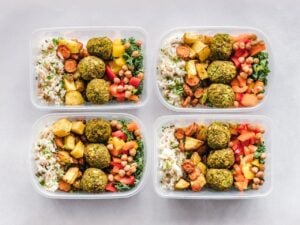How To Read Food Nutrition Labels

Food labels can be overwhelming. There are so many numbers, percentages, and abbreviations that it’s hard to know how to make sense of them all. Luckily, you don’t have to memorize what everything means—you just need to understand the basics. In this post, we’ll explain how to read food nutrition labels and what these numbers mean for your health.
How to Understand Nutrition Labels
The FDA requires the Nutrition Facts label on all packaged foods sold in the United States, making it a reliable source of information. If you’re wondering how to understand nutrition labels, you’re not alone. Although they should help consumers make informed decisions about their diet, nutrition labels can be confusing. To learn how to read food nutrition labels, start at the top with serving size.
Serving Information
The serving size is the amount of specific food or drink you should consume in one sitting. This number is usually the first thing listed on the nutrition label because it provides important context for everything else. It’s based on the amount of food the FDA considers healthy for most people, and it varies from product to product. For example, a serving of pasta may be two ounces while a serving of vegetables may be five ounces. In other words: there is no universal definition for “serving size.”
The serving size listed on food nutrition labels serves as a reference point for calculating how many calories or nutrients are in your food. The serving size may not actually be what you end up eating, though. It’s important to keep this in mind, especially when looking at calories and sugar count. For example, if there are three servings of a snack in the bag and you eat the whole bag at once — you need to multiply all the numbers on the rest of the label by three!
For those used to eating a standard American diet, the portion sizes may seem small at first. But, if you’re trying to limit your caloric or sugar intake, measuring out portions based on recommended serving sizes will help ensure that you don’t accidentally overeat.
Calories
When thinking about how to understand nutrition labels, you need to know the basics. Calories have a bad reputation, but it’s important to understand that calories are not inherently unhealthy! Calories are a measure of the amount of energy in food, and we all need energy for our bodies and minds to function.
However, when your caloric intake exceeds the number of calories you actually burn in a day, your body converts that extra energy into fat stores. If you consume fewer calories than you burn, your body converts fat stores into energy (a process called “burning fat”).
This is a defensive ability many animals have to prevent starvation from times when food access was more unreliable. Unfortunately, our metabolism hasn’t caught up to the standard American diet! Eating fewer calories per day than you burn is a reliable way to lose weight.
Calories are listed on Nutrition Labels in bold letters right beneath the serving size at the top of the table. Remember that if you eat a larger portion than the recommended serving size, this number may only reflect a percent of the total calories you consume.
Nutrients
Nutrients are generally divided into the ones you may want to limit, and the ones you want to get more. Depending on your diet, health needs, and exercise schedule you may need more or less of each nutrient.
Generally, most Americans should seek to limit the amount of saturated fat, sodium, and added sugars they consume. According to the FDA, these nutrients are associated with negative health impacts and most Americans already consume too much of them.
Nutrition labels break sugar down into two categories: total sugars and added sugars. People often wonder what the difference is between these two categories when figuring out how to understand nutrition labels. Total sugars include all sources of sugar, including some that are naturally present in healthy foods (like fruit). There is no daily recommended value for total sugars. Added sugars, on the other hand, include processed sugars that have been added to the product for sweetness. You should avoid these as much as possible!
Also in this section of the label are important nutrients you need for healthy functioning. These include dietary fiber, vitamin D, calcium, iron, and potassium. Look for foods high in these values!
Percent Daily Value
The percent daily value (% DV) is the amount of each nutrient present in one serving size of the food or drink. The percentage is calculated relative to the recommended daily amount of each nutrient, based on a 2,000-calorie per day diet. This number helps people determine if they’re getting enough nutrients in their diets or consuming too many negative calories. Despite being important, this is one of the most confusing aspects of how to read food nutrition labels.
For example, the USDA recommends that most people get 1,000 mg of calcium per day. So, if a serving of food contains 100 mg of calcium, this means the serving contains 10% Daily Value of calcium.
The same applies to items on the food label you may want to avoid, like fat and cholesterol. For example, 15 grams is 20% Daily Value for total fat. This means that for a standard diet of about 2,000 calories per day, 77 grams is the total daily recommended amount of fat you should consume.
Keeping an eye on these numbers can help ensure that you hit all of your recommended nutrients per day.
How Meal Kits Make Eating Healthy Easy
Now you know how to read food nutrition labels. But if you’re tired of scouring tiny food labels in grocery stores, there’s an easier way! Eating healthy is easier than ever with meal kits. A meal kit contains all the ingredients you need to make a delicious and nutritionally complete dish, delivered to your door. There are many benefits to meal kits including that they are convenient, easy to make, and easy to clean up.
With a meal kit service like Gobble, you can choose from different meals each week to add variety to your table. Gobble also offers a Lean & Clean plan which allows you to select meals with healthy proteins suitable for any diet.
Get the Nutrients Your Body Needs
Now you know how to understand nutrition labels to make important decisions about what you put into your body. When shopping for groceries, look for fresh and healthy ingredients with more beneficial nutrients like dietary fiber, vitamins, and minerals. Avoid saturated fat, sodium, added sugars, and extra calories you don’t need.
With your new knowledge of how to read food nutrition labels, you are prepared for a lifetime of informed food choices!



